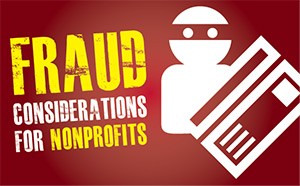Nonprofits are frequently the victims of embezzlement and employee fraud because they tend to have looser financial controls than for-profit businesses. The management and board members are also likely to be much more trusting of employees. This type of fraud is frequently not even reported or prosecuted due to the financial costs of an investigation and the concern over donors finding out that their funds were not appropriately overseen.
Some recent examples of nonprofit embezzlement include:

A former bookkeeper and office manager at the House of Ruth was sentenced to a year in prison. She pled guilty to federal charges of misappropriating $138,370 in federal funds and embezzling $238,000 from the organization’s bank accounts. – August 2009 The former CFO of the Association of Fish and Wildlife Agencies pled guilty to wire fraud. She was a ten year employee of the organization who worked her way into management. She used the organization’s credit card to charge approximately $184,000 in personal expenses, including hair and make-up expenses and casino debts. – September 2009 The former Executive Director of the Oklahoma CASA Association was sentenced to 15 years in prison after she pled guilty to embezzling almost $550,000. She was a long-time employee and had used the organization’s credit cards for personal expenses such as foreign vacations, cosmetic surgery, and college tuition. – September 2009
Notable among each of these three examples; the perpetrator was an officer or manager of the nonprofit. Therefore, the nonprofit board must take their role in fraud and embezzlement prevention seriously. Boards cannot depend solely on management to undertake this task, because it could be those very individuals who are committing the crime and using the lax oversight to their benefit.
There are many steps that can be taken to prevent embezzlement. While a determined employee can work around almost any system to commit fraud, having an effective plan is essential to deterring the activity.
- For expenditures over a predetermined amount, require two signatures on every check and two authorizations on every cash disbursement. Since many nonprofits are too small to effectively implement this policy, consider having a board officer or director as the second signatory.
- All check and cash disbursements must be accompanied by an invoice showing that the payment is justified.
- Don’t pre-sign checks. Many nonprofits do this, if their executive director is going out of town, for example. This is an invitation for an unscrupulous employee to take one of those checks for personal expenses.
- If your organization uses credit cards, the person using the card cannot be the same person approving its use and accompanying charges. Have a board director or officer review the credit card statements and accompanying expense reports of the Executive Director, CFO, CEO, etc.
- No single individual should be responsible for receiving, depositing, recording and reconciling the receipt of funds (money coming in). Additionally, no one person should be responsible for authorizing payments, disbursing funds, and reconciling bank statements (money going out). Again, if the organization does not have enough staff on hand to segregate these duties, a board director or officer should reconcile the bank and credit card statements.
- All contracts should be subject to at least three bids, and approved by a manager uninvolved in the transaction. Large contracts should be reviewed and voted on by the board.
- Conduct a fixed asset inventory review at least once per year to ensure that no equipment (computers, printers, etc.) is missing. While you’re at it, write down the serial numbers of the equipment and consider engraving an identifying mark on each item in case of theft.
- Background checks on new employees and volunteers are important. They can reveal undisclosed criminal records and prior instances of fraud, allowing you to avoid a bad hire in the first place. They are also fairly inexpensive, so can easily become part of your hiring process.
- External audits can be helpful in ensuring that the fraud prevention measures are being followed and are effective. However, be aware that a typical audit cannot be relied on to detect fraud.
- It is critical to have a whistle-blower program. If you only implement one of these steps, this is the one. It is unlikely that fraud, theft or mismanagement has gone completely unnoticed by everyone involved with the organization. Oftentimes, employees are aware of theft but have no safe way to report it, especially if the suspect is their direct supervisor or the Executive Director. They may not report on theft or mismanagement if they believe their job is in jeopardy. Employees must have a manner in which to contact a board officer in the event something needs to be reported. Board officers must be prepared to take these reports seriously, keep the reporting employee protected, and contact legal counsel.














